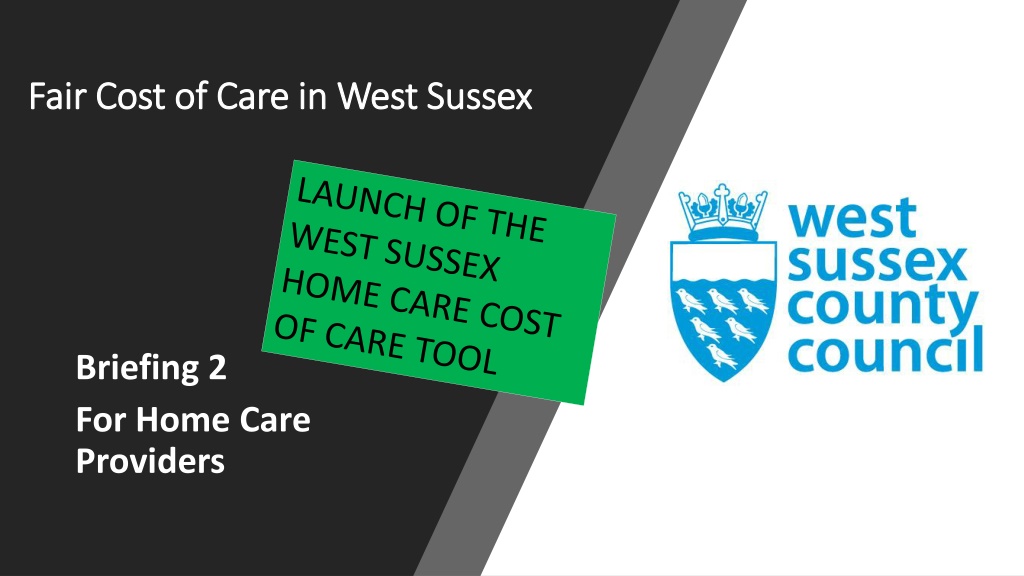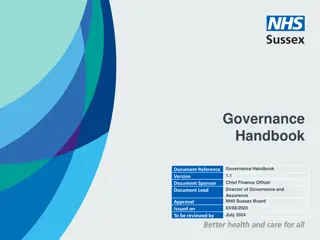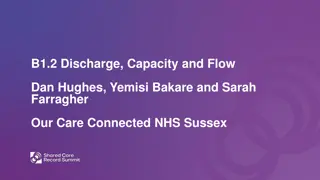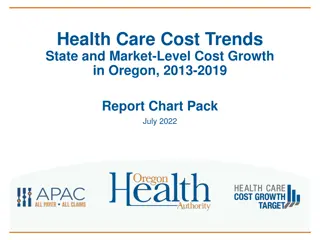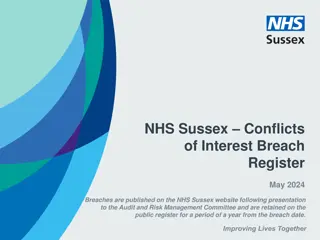Insight into Fair Cost of Care Initiative in West Sussex
The briefing provides an overview of the Fair Cost of Care initiative in West Sussex, focusing on the challenges faced by care markets, requirements set by the government for local authorities, and the Cost of Care Exercise. It emphasizes the importance of developing a Market Sustainability Plan and the need for a fair cost approach in delivering home care services. The briefing also introduces a new fund to support local care costs and outlines the upcoming deadlines and key objectives.
Download Presentation

Please find below an Image/Link to download the presentation.
The content on the website is provided AS IS for your information and personal use only. It may not be sold, licensed, or shared on other websites without obtaining consent from the author. Download presentation by click this link. If you encounter any issues during the download, it is possible that the publisher has removed the file from their server.
E N D
Presentation Transcript
Fair Cost of Care in West Sussex Fair Cost of Care in West Sussex Briefing 2 For Home Care Providers
Well give you a quick summary of the first briefing which went into more detail about the overall background. We officially launch the cost of care tool here and provide details about how to complete and deadlines for completion In this briefing We share with you Frequently Asked Questions about the cost of care generally and some of the specific questions raised by home care providers about the cost tool being used We ll tell you more about the Market Sustainability Plan we want to co-design with you which aims to tackle important issues facing us in West Sussex
Care markets across the UK have struggled as Local authorities (LAs) have needed to ensure rates are affordable due to shrinking budgets Providers have worked in a challenging market with increasing cost pressures Self-funders often pay higher rates than those negotiated by LAs and subsidise providers costs The Govt White Paper (December 21) People at the Heart of Care: Adult Social Care Reform aims to ensure that people who self-fund their care do not have to pay more than local authorities for the same service Quick Summary of Briefing 1 The Govt requires all local authorities to: Carry out a Cost of Care Exercise Develop a Market Sustainability Plan The outcome of the cost of care exercise and a draft plan need to be submitted by 14th October 22 (with the developed plan submitted in February 23) It also introduces a new Market Sustainability and Fair Cost of Care Fund - 600m nationally for each of the next two financial years. Completion of the Cost of Care Exercise is a condition of receiving any funding which can be used to support local care costs.
Its an evidence-based approach where providers share the costs they face in delivering home care & residential or nursing care It recognises the real cost pressures facing providers as well as the reasonable returns needed from operations and capital What is the Cost of Care exercise? It uses cost tools that have been developed in consultation with providers and LAs which ensure a consistent and a balanced approach to establishing a fair cost. We will be using the ARCC Dom Care Tool see slides below for more details and links to access the tool. The upper quartile, median and lower quartile costs in each of the markets are submitted to govt, with the median referred to as the Fair Cost of Care Each LA develops a plan to look at the impact of market changes over the next 3 years and how to make local markets more sustainable LAs will also have to set out by February 2023 how they will move towards the fair cost of care.
3 questions 3 questions our Market Sustainability Plan needs to answer Sustainability Plan needs to answer our Market What is the What is the West Sussex West Sussex Market Market Sustainability Sustainability Plan? Plan? 2. What changes are needed to sustain the business of caring in West Sussex? 3. What action do we need to take? 1. What are the key issues that need to be tackled? Recruitment and retention? Sharing information about customer needs and complexity? Data on county demographics? Commissioning with the council? Planning the direction the market needs to take e.g. stronger focus on supporting people at home, greater focus on complex needs/dementia within residential? Look out for more announcements in July ..
WSCC has officially launched the tool on 4th July. When do we need to complete the cost of care tool? It s available now and should be completed by 3pm Monday 1st August 2022 Please send us your response as early as possible before the closing date so that we can review it with you in the event of any queries. Don t forget to ask for guidance on issues you re facing when you start to complete the tool contact us on costofcare@westsussex.gov.uk
How can I How can I get hold of get hold of the home the home care cost care cost tool? tool? Download the Excel based tool from here
Cost of Care Frequently Asked Questions
Index of Questions Slide 25/26 - More than one local authority purchasing from one location Slide 10 - Who is this aimed at? Slide 27 More than one branch in West Sussex Slide 11 What s the goal of this? Slide 28/29 What period of time should the information be related to? Slide 12 How have other providers responded to this? Slide 30 Can I just put in general staff cost information? Slide 13 Just for providers commissioning by West Sussex? Slide 29/30 Return on operations and capital Slide 14/15 Supported Housing in scope? Extra Care? Slide 31 Accounting for PPE costs Slide 16 Is this is about reducing the price providers can charge? Slide 32 Avoiding double counting Slide 17 Why should we share our costs with the council? Slide 18/19 - How is this data going to be used? Slide 33 - Most useful tip for inputting costs? Slide 20 How could using the cost tool benefit me? Slide 34 Handling different types of uplift for staff depending on circumstances Slide 21 It looks complicated .. Slide 35 Travel costs Slide 22 What if I struggle to use the tool? Slide 36 - If I submit costs, will the council pay them? Slide 23 Who can support me? Slide 24 - Who needs to complete the information? Slide 37-41 Useful information
Home care/domiciliary care providers across England (+18 services) Who is this Who is this aimed at? aimed at?
The government would like to Reduce the differential between the LA rate and the self-funder rate Bolster market sustainability including funding, investment, support and training for staff What s the goal What s the goal of all this? of all this? Local authorities would like to receive more funding to be able to pay sustainable rates in the care market Providers would like to have a sustainable business and be able to charge rates that cover their costs and a return on investment
The Care Provider Alliance has said it is critical that providers engage in the Fair Cost of Care data collection exercise to determine the actual cost of providing high quality care nationally to see the appropriate level of funding from the government. This is a one-off chance to evidence the cos of provision locally and nationally to compensate providers appropriately against the reforms to be introduced which will see those self- funding their own care to access the local authorities rate paid for care. How have How have other other providers providers responded to responded to this? this? Professor Martin Green, Chief Executive of Care England & Dr Jane Townson, Chief Executive of the Homecare Association are encouraging all providers to take part in this national cost of care exercise and inform their local authorities of the true costs of delivering social care.
We are asking all providers in West Sussex to complete the tool If you are a provider of 18+ home care or 65+ residential/nursing homes Regardless of whether or not you are currently providing services commissioned by West Sussex County Council You may in fact have a business which is fully focused on self funders. Is the cost of care just for providers receiving business from WSCC? This will help to get a wide picture of the real costs facing providers in the region And make sure that the information we base our plans on is accurate
Supported living is out of scope Is my supported living service in scope? There are a couple of people over 65 living there . Extra care is out of scope although if you are a dom care service working in the community and also provide services within an extra care scheme, all of your services are within scope Check out the official guidance on the next page which helps to define what s in and what s out of scope If in doubt, contact us on costofcare@westsussex.gov.uk costofcare@westsussex.gov.uk
Example 1: A care home that supports older people and has a resident who is aged 60 in scope. Example 2: A care home that supports working age adults and has a resident aged 69 out of scope. Example 3: A domiciliary care provider based in an extra care housing scheme that delivers the majority of their care in that scheme but some in the local community out of scope. Example 4: A domiciliary care provider delivers a range of community-based support (sitting services, live in support, domestic support), but the vast majority of the support they provide is for people aged over 18+ and consists of long term care, with a regular pattern per week, consisting of relatively short visits in scope.
This is about This is about reducing the reducing the price price providers can providers can charge, isn t charge, isn t it? it?
The government is trying to ensure that providers have their actual costs covered in the rates paid by local authorities as well as self- funders Why should Why should we share our we share our costs with costs with the council? the council? Providers have often said that local authorities aren t considering the full costs that they have to pay so this is a major opportunity to make sure that the real costs of care are known and taken seriously
Shouldnt I Shouldn t I be suspicious be suspicious of how this of how this data is going data is going to be used? to be used?
How will How will the data I the data I provide be provide be used by used by WSCC? WSCC?
Help to ensure sustainable rates in West Sussex How could using the cost tool benefit me? But also Modelling the impact on your bottom line of changes to your staff profile and/or changes to what you pay for travel (e.g. increased travel time or mileage rate) Modelling different scenarios e.g. taking on a new area of business in a more rural part of West Sussex
It looks more complicated than it is It looks complicated looks like I need a qualification before I can use it! Good advice is to look at the tool first and see what information you need to gather before you try to input your costs There s lots of guidance as you work your way through the tool If you get stuck or find something difficult to figure out, use one of the sources of support you can find at the end of this briefing
What if I struggle What if I struggle to know how to to know how to use the cost use the cost tools? tools?
We are very pleased to announce that we have appointed Laing Buisson to work with us to analyse the data and produce our cost of care report. You may already be familiar with Laing Buisson as a leading business intelligence provider working in the health, care and education sectors. Laing Buisson have a great deal of experience working with providers on the cost of care, producing annual market reports for adult specialist care, care homes and many other areas. Laing Buisson will: Laing Buisson - Additional support Contact all providers by telephone during July to encourage providers to participate Provide guidance, assistance and advice so that providers can complete the cost of care exercise including talking through how to fill the tools in (9am - 5pm, Monday to Friday by telephone, email or Teams call) Contact providers after tools have been returned Laing Buisson has a team that will be verifying the returns and will contact you if any anomalies are found or to support you if the toolkit hasn't been filled in correctly. Laing Buisson can be contacted via Estelle O Neill (Senior Researcher) on 01268 767292 Email: estelle.oneill@laingbuisson.com
Who needs Who needs to complete to complete the the information? information?
Three factors are important in determining how to approach this: My care business provides care from a single location but to more than one local authority. FACTOR 1 - The proportion of care a provider delivers on behalf of different local authorities, private clients and other commissioners FACTOR 2 - The extent to which these costs are the same or different. FACTOR 3 - The way the provider collates and holds cost and activity information For domiciliary care: If the situation is relatively simple (e.g. you deliver 90% of your care on behalf of a single LA) and / or consistent (e.g. costs of care are similar regardless of who commissions the care) then the best approach is likely to be to create a single return that covers all costs and provision, which is then submitted to all local authority/s that commission care from you. If the situation is less simple (e.g. you deliver equal amounts of care for 3 different LAs) and / or less consistent (e.g. the costs of providing on behalf of each LA differ), then you should consider submitting separate returns that only include the costs and provision relating to that specific local authority. How should I treat this in the West Sussex cost of care response? Some providers have reported that it is relatively simple for them to apportion costs associated with different provision. If they work with different local authorities and / or there is any difference in costs, they may wish to create and submit separate returns for the different local authorities that commission from them. Others may find it more difficult to disentangle costs leading to costs which aren t accurate. See next slide for scenario
Scenario: A domiciliary care provider delivers a third of their care for local authority A, a third for local authority B and a third for private clients and wishes to submit cost information to local authority A and B. Approach 1:The provider s costs across the 3 types of provision are broadly the same, so the provider creates a single return covering 100% of their provision and 100% of their costs and submits this to local authority A and B. Approach 2: Similar to approach 1, the provider creates a single return covering all of their costs and all of their provision. This reflects the costs they incur in local authority A and so is submitted to that local authority. However, the provider incurs slightly higher travel time and agency costs in local authority B and so these figures are amended to proportionately increase the cost for local authority B. This is submitted to local authority B. Approach 3: The provider believes their costs are so different across local authority A and B and the private clients that it is not possible to create a single return. The provider creates entirely separate returns for local authority A and B and apportions cost appropriately according to the amount of care delivered.
I have more than one branch in West Sussex how should I complete the cost of care spreadsheet? The whole purpose of the cost of care exercise is to accurately capture the real costs of providing domiciliary care in the locality We would expect to see differences in cost Within each branch Between more urban and rural areas in West Sussex So we are asking providers to complete one cost of care spreadsheet for every local branch in West Sussex
The most important principle is that costs & information should be based on actuals and not an assumption about what costs are or might be. We would like all providers to use actual annual figures for the 21/22 year. However, some parts of the tool require a slightly different approach to make sure that you are able to provide the most accurate picture. Where you already know and can evidence that a higher cost for a given item will be incurred you are able to include this information. The following are examples What time period should the information I provide relate to? Example 1 Cost of sickness absence - This should be based on 21/22 actual costs, or average calculations based on those actual costs for the year in order to provide a average weekly figure. Example 2 Staff pay increases since 21/22 - If you have given your staff a pay increase since 21/22 then we would like you to use the most up to date information. Example 3 Annual Insurance - If you know that the actual cost of your insurance is due to change (as you have already received renewal information), you can use the new figure. Example 4 Occupancy over the year - Here you need to provide an average in order to reflect changes that take place over the whole 21/22 period. To be sure that you are providing the relevant costs, Laing Buisson will be in contact with you in order to: clarify whether your relevant costs are 21/22 or 22/23 ask you for your 22/23 basic direct pay staff rates if you haven t included them ON THE NEXT PAGE YOU LL FIND A GUIDE TO THE INFO REQUIRED IN THE TOOL AND THE TYPE OF DATA YOU NEED TO USE
Where an annual figure or an average is required for 21/22 Section A visits per week and visit length Section B Average travel distance (miles) & time (minutes) Section C Average number of service users Section D Items required per visit/% PPE calls Section E - % Call allocation for different types of staff Section F - % of total for non contact pay costs and training and supervision days Section G average care staff per annum & % staff opt out (although this may also be a snapshot figure if more up to date data is available) Section H Number of FTE Staff Section I Additional back office Pay Costs Section J All of the items in this section except rent/rates/utilities/insurance and central office recharges (see below) Section K Operating profit Where you have up to date information on actual costs you can enter the most recent data you have evidence for. For example you have uplifted pay rates for staff after April 2022. This would apply to several sections including Section B mileage/travel expenses pay (p/mile) Section D Cost p/unit Section E base pay rate and uplifts for enhancements Section G Employers NI Threshold 2022/23 - 9,100 Section H Back office pay costs: Gross pay Section J Rent/Rates and Utilities Insurance Central/Head office recharges But if confused you can get help by emailing your query to costofcare@westsussex.gov.uk
The tool is designed to be completed with details of costs Not just generic staffing costs But costs of senior carers, carers, nursing staff etc Can I just put in Can I just put in general general cost information? information? cost This helps to make sure that the West Sussex Cost of Care exercise is real and based on actual costs, not generalised information
We appreciate that providers may not have faced actual costs for PPE during 21/22 but will do in future. For consistency, we are asking providers to take the following approach: How should I account for PPE costs? Show the amount/volume of PPE used Populate the cost of care tool to state the amount of PPE you used per visit This will automatically calculate total PPE usage and give a factual measure of the volume of PPE used. In relation to the cost of PPE State the costs of PPE since April 2022 Both of these will enable the tool to capture the overall cost of PPE going forward
Double counting You need to be careful using the tool in order to avoid double counting Example 1 home care travel time If you pay your staff for their travel time within your hourly rate, rather than paying a separate amount You can include it within your direct staff costs (section E) BUT NOT ALSO in your travel time and mileage expenses (section B) Example 2 home care back office staff and central overheads If you have back office staff, you can list your related salary costs in Section H BUT NOT ALSO as part of your non-salary costs in Section J related to central overheads For guidance contact us on costofcare@westsussex.gov.uk
You dont have to do it in one sitting What s the most useful tip for inputting my costs? But use the save button regularly!
The homecare tool, for example, enables you to reflect different enhancements by job type/job role. We don t have a set We don t have a set uplift for weekend uplift for weekend rates as staff are rates as staff are paid differently paid differently depending on their depending on their qualifications. But all qualifications. But all staff are paid either staff are paid either 50p or 1 extra per 50p or 1 extra per hour at weekend hour at weekend and evenings. and evenings. If you pay enhancements dependent on other factors such as qualifications you will need to use an average across the relevant job roles Shall we just use Shall we just use averages based on averages based on the total staff uplift? the total staff uplift?
The first thing to establish is whether you pay travel costs: We pay for travel differently depending on the situation e.g. whether staff have company car or their own or Included within the hourly rate you pay Separately If you pay within your hourly rate, don t add travel costs separately to your cost of care return to avoid double counting car. How can we reflect this in the If you pay a range of separate rates depending on circumstances, use the average e.g. average per mile mileage rate tool?
This exercise is about gathering the real costs that providers face in delivering their business It doesn t immediately establish a new price If I submit my If I submit my costs, will the costs, will the council start council start to pay them? to pay them? We re hoping that providers not currently being commissioned by the council will also submit their costs We ll be looking at the median costs of delivering care. This median is referred to by govt as the fair cost of care. We are able to remove outliers that are likely to skew the median The government will be asking (via our Market Sustainability Plan) how we plan to move towards the fair cost of care over a period of time
Valuable Valuable Sources of Sources of Help and Help and Information 1 Information 1 General Guidance on the Cost of Care Email WSCC with any queries at costofcare@westsussex.gov.uk DHSC publication Market Sustainability and Fair Cost of Care Fund General info General info Latest DHSC Guidance on the Market sustainability and fair cost of care fund 2022 to 2023
Valuable Valuable Sources of Sources of Help and Help and Information 2 Information 2 How to access the Home Care Tool Download the Excel based tool from here Support and guidance on the Home Care Tool FAQs, instruction videos, demo recordings and other support Support Website Home Care Home Care tool tool
marketsreform@dhsc.gov.uk Managed by Department of Health and Social Care (DHSC) This is the most appropriate helpdesk for any questions or clarification about the DHSC Guidance, funding conditions or wider charging reform. Cost of Care Helpdesk Emails MarketsandCommissioning@local.gov.uk Managed by CHIP and is likely to be of most benefit to local authority colleagues delivering cost of care exercises and seeking guidance, clarification and support. FCC@CareProviderAlliance.org.uk Managed by Care Provider Alliance and is likely to be of most benefit to provider colleagues participating in cost of care exercises and seeking guidance, clarification and support. CareCubed@iese.org.uk Managed by iESE, who have developed the Care Home Cost of Care Tool. This should be used for technical questions about the Tool and to provide feedback and suggestions. support@CostOfCareToolkit.co.uk Managed by ARCC-HR Ltd, who have developed the Domiciliary Care Cost of Care Tool. This should be used for technical questions about the Tool and to provide feedback and suggestions.
For your calendar For your calendar: West Sussex Events, guidance and support WSPiC Managers Forum 14th July 09:30-12:30 Field Place, Worthing https://goo.gl/maps/8UV729nfTrrYMusk8
For your calendar For your calendar: West Sussex Events, guidance and support Fair Cost of Care Support for Care home and Home Care Providers FOR CASCADE The Care Provider Alliance (CPA) has been tasked by the DHSC to support providers of Care Homes and Home Care to participate in the Fair Cost of Care exercise nationally. The CPA have been running dedicated workshops for councils and providers to see national tool demos (iESE Care Cubed for Care Homes and the LGA Toolkit for Home Care) and to answer FAQs. HOME CARE: 8th July 2022 3pm to 4pm Click here to join the meeting Please copy and paste this link into your diary to join the meeting the tool section you require support upon (CLICK HERE) HOME CARE: Pre-Recorded demo with a helpful index, to navigate to
